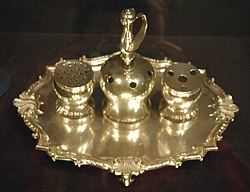Philip Syng

Philip Syng (September 29, 1703 – May 8, 1789)[1] was, like his namesake father, a renowned silversmith who created fine works in silver and sometimes gold for the rich families of Philadelphia, Pennsylvania. In 1752 he created the Syng inkstand, which was used to sign the United States Declaration of Independence and United States Constitution.
Syng was a member of Benjamin Franklin's Junto, and was a founder of the Library Company of Philadelphia, the Union Fire Company, Philadelphia Contributionship, Pennsylvania Hospital, and the American Philosophical Society. He was a founding trustee of the Academy and College of Philadelphia (now the University of Pennsylvania), serving from 1749 to 1773. Syng was also elected to various public offices including city assessor, warden of the port, and treasurer of the city and county of Philadelphia.
Syng died in Philadelphia in 1789, and is buried at Christ Church Burial Ground.
References
- ^ Voss, Wm Erik (2005). "Philip Syng (1703-1789)". ancestry.com. Retrieved July 12, 2016.
